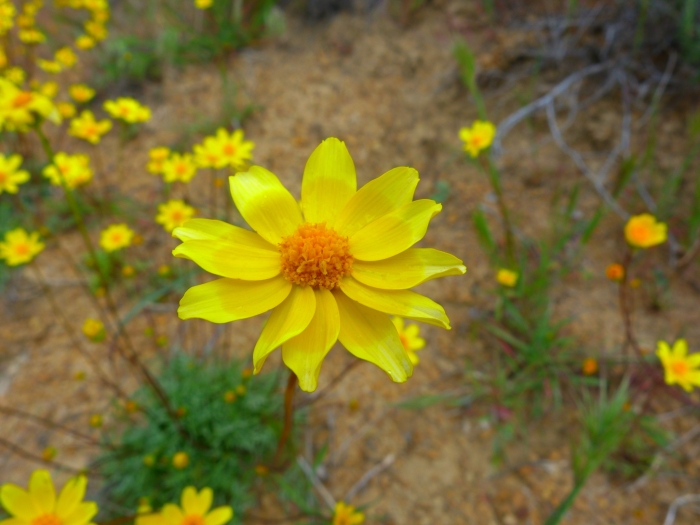Bigelow’s Tickseed
(Coreopsis bigelovii)
Bigelow’s Tickseed (Coreopsis bigelovii)
/
/

Zack Abbey
CC BY 4.0
Image By:
Zack Abbey
Recorded By:
Copyright:
CC BY 4.0
Copyright Notice:
Photo by: Zack Abbey | License Type: CC BY 4.0 | License URL: http://creativecommons.org/licenses/by/4.0/ | Rights Holder: Zack Abbey | Publisher: iNaturalist | Date Created: 2017-04-17T10:24:08-07:00 |




















Estimated Native Range
Summary
Coreopsis bigelovii, commonly known as Bigelow’s tickseed, is an annual herb native to various habitats within California, including chaparral, coastal sage scrub, desert washes, and open woodlands, particularly in the southern California Coast Ranges, southwestern Sierra Nevada, Transverse Ranges, and the Mojave and Colorado deserts. It typically grows from 4 to 12 inches tall with multiple stems and a basal rosette of leaves that are divided into narrow lobes. The inflorescences are erect, featuring solitary flower heads with bright yellow disc florets surrounded by 5-10 ray florets that can be up to 1 inch long. The fruit is a small achene. Bigelow’s tickseed blooms from March to May, with flowers that are moderately showy and attract pollinators.
Bigelow’s tickseed is valued for its drought tolerance and ability to thrive in poor, well-drained soils, making it suitable for xeriscaping and wildflower gardens. It is also used in restoration projects due to its adaptability. The plant has historical culinary use by the native Kawaiisu and Tübatulabal peoples, who consumed it as a raw or cooked green vegetable. In cultivation, it requires minimal water once established and prefers full sun to part shade. While generally disease-free, it can be susceptible to root rot if overwatered. It is not known to be invasive and does not have aggressive roots, making it a safe choice for various garden settings.CC BY-SA 4.0
Bigelow’s tickseed is valued for its drought tolerance and ability to thrive in poor, well-drained soils, making it suitable for xeriscaping and wildflower gardens. It is also used in restoration projects due to its adaptability. The plant has historical culinary use by the native Kawaiisu and Tübatulabal peoples, who consumed it as a raw or cooked green vegetable. In cultivation, it requires minimal water once established and prefers full sun to part shade. While generally disease-free, it can be susceptible to root rot if overwatered. It is not known to be invasive and does not have aggressive roots, making it a safe choice for various garden settings.CC BY-SA 4.0
Plant Description
- Plant Type: Herb
- Height: 1-2 feet
- Width: 1-1.5 feet
- Growth Rate: Moderate
- Flower Color: Yellow
- Flowering Season: Spring, Summer, Winter
- Leaf Retention:
Growth Requirements
- Sun: Full Sun
- Water: Low
- Drainage: Medium, Fast
Common Uses
Border Plant, Butterfly Garden, Deer Resistant, Drought Tolerant, Low Maintenance, Rabbit Resistant, Rock Garden
Natural Habitat
Native to chaparral, coastal sage scrub, desert washes, and open woodlands within California
Other Names
Common Names: Bigelow Coreopsis
Scientific Names: , Coreopsis bigelovii, Coreopsis bigelovii, Leptosyne bigelovii, Pugiopappus bigelovii, Pugiopappus breweri,
GBIF Accepted Name: